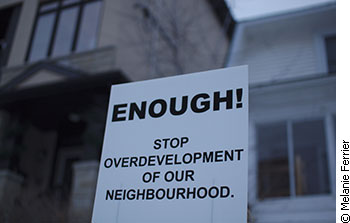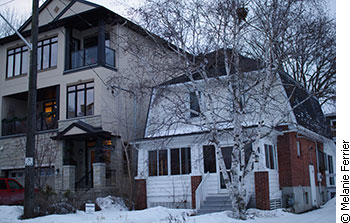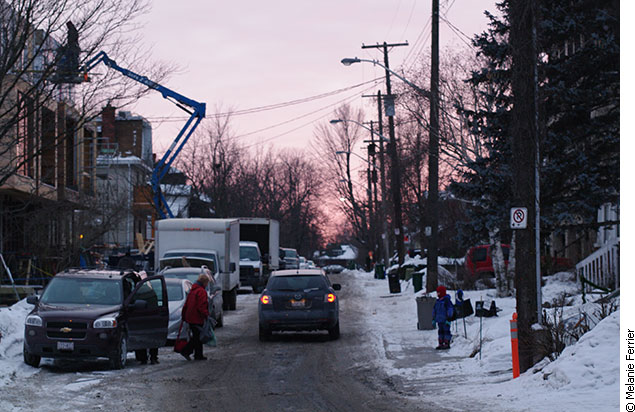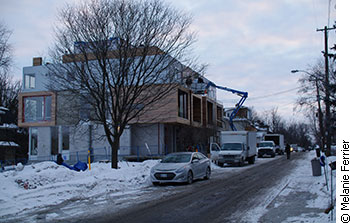Number 33 Brighton is a quaint, old house with white wooden panelling and a wide front porch. In the middle of its snow-covered garden protrudes a flimsy, wire-framed sign that reads, “Enough! Stop overdevelopment of our neighbourhood.”
 Signs of frustration mark lawns in Old Ottawa South. In 2008, Campanale Homes bought the house next door. They tore down the one-and-a-half storey clapboard home and built a towering three-storey duplex in its place.
Signs of frustration mark lawns in Old Ottawa South. In 2008, Campanale Homes bought the house next door. They tore down the one-and-a-half storey clapboard home and built a towering three-storey duplex in its place.
That’s when Lori Pope bought her wire-framed sign.
“My neighbour on the right had one,” she says. “He had a couple extra, so I bought one off him.”
Pope says the sign can be read by anyone walking by, but the message is for potential developers. If a property scout drives by her home, she wants him to know that there are a lot of people in the neighbourhood who are concerned about inappropriate infill.
THE GROWING POPULARITY OF INFILL
Despite local hostility, infill development has become a popular option for small Ottawa developers
“If you go to the suburbs, you’re competing with the Mintos and the larger builders,” says Joe Tratch, owner of Legacy Homes. “When you’re starting out, it’s a lot easier to do infill. There’s not the same competition.”
Tratch has been replacing old, one-family homes with modern multiplexes since 1998. He says that’s when the City started to restrict residential development to land within Ottawa’s Greenbelt.
They’ve not just restricted development. Trach says that over the last few years the city has been actively encouraging infill.
“Ottawa’s one of the biggest cities in Canada. If we keep on building subdivisions when everyone works downtown, our infrastructure’s not going to be able to handle that.” “They want to make the best use of the city’s infrastructure,” he says. “Ottawa’s one of the biggest cities in Canada. We’re spread out from Rockcliffe to Kanata to Barrhaven. If we keep on building subdivisions when everyone works downtown, our infrastructure’s not going to be able to handle that.”
Tratch started looking at how his company could maximize land within the urban core, but it wasn’t easy. Ottawa was a dense city to begin with and now the big companies were moving in, looking for property to build towering condominiums on.
So Tratch stopped looking for land and started looking at old houses. When he found a small home on a double lot, he’d buy the house, tear it down and build two or three new ones.
Building infill appeals to Tratch because it allows him to build one house at a time.
That’s easier on his company’s finances, but Tratch says it’s also safer. He says it makes his company less vulnerable to changes in the market.
A BALANCED MARKET
 New infill is breaking into old Ottawa neighborhoods. Infill developers may be less vulnerable when the market goes through a slump, but they’re not immune.
New infill is breaking into old Ottawa neighborhoods. Infill developers may be less vulnerable when the market goes through a slump, but they’re not immune.
In 2011, the Canadian Mortgage and Housing Corporation reported a sharp decline in the number of new homes that were built in Ottawa during the year. That number was up in 2012, but analyst Sandra Perez Torres says that the market hasn’t fully recovered.
“We’re now in a balanced market,” she says. “Neither the buyers nor the sellers have the upper hand because there’s about the same amount of houses out there as there are people who want to buy.”
When markets are balanced, Parez says developers can’t expect to sell their houses as quickly as they did in the past. Buyers are going to take their time, so she says developers have to be patient.
But infill developers can’t always afford to be patient.
CONDITIONS LESS THAN IDEAL
Jakub Ulak is working on a controversial infill project in Old Ottawa South, just down the street from Lori Pope. He says his company can’t start another development until this one sells. That’s because Ulak holds a mortgage on the property and, until he finds a buyer, he has to pay interest on that loan.
“We’re not a company that builds and holds real estate,” he says. “We’re about building and selling properties.”
In a balanced market, selling properties means being creative: Ulak is offering $20,000 to anyone who connects him with a buyer.
“It gives me what I’m looking for,” he says. “At the same time, it gives people a really good deal.”
NEIGHBOURS AREN’T IMPRESSED
A good deal for some, but Janet Jull would rather have a say in how infill developments are designed.
Jull started organizing her neighbours against big infill when Marino Construction bought the property next-door. When she saw the design for a three-storey triplex, Jull tried to complain, but the company wasn’t interested in talking. Instead, it hired a lawyer.
“I was just so frustrated. There was nothing I could do, because this developer didn’t care. It was just a big money grab.” “I was just so frustrated,” she recalls. “There was nothing I could do, because this developer didn’t care. It was just a big money grab.”
The neighbourhood organization—informal as it is—does seem to be making a difference. Jull has another infill going up on the other side of her home and, though it’s big and boxy, she has no issue with this one. The builder consulted the neighbours before construction started and Jull says that made all the difference.
“It doesn’t take much to make citizens happy,” she says. “You just want to know that you’re heard.”
But the drive to build infill and sell quickly still tends to drown out voices like Jull’s. As long as market conditions challenge small developers, Jull is afraid friendly developers will be few and far between.


